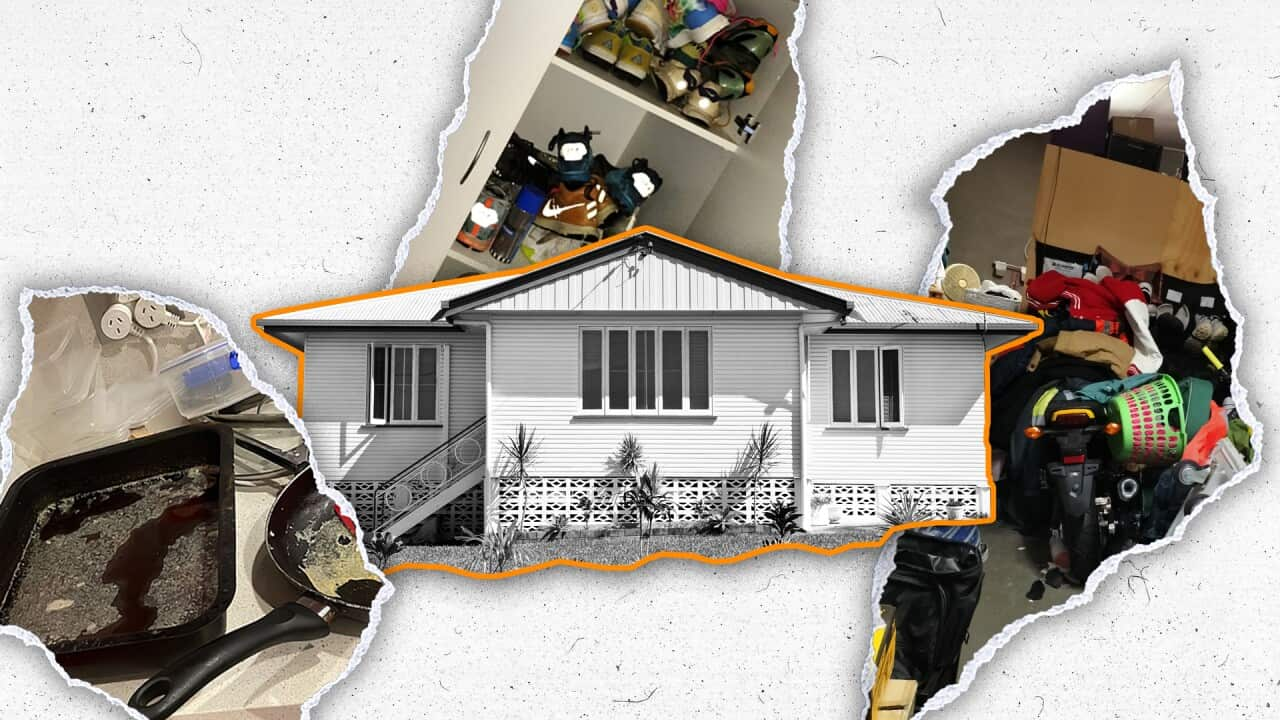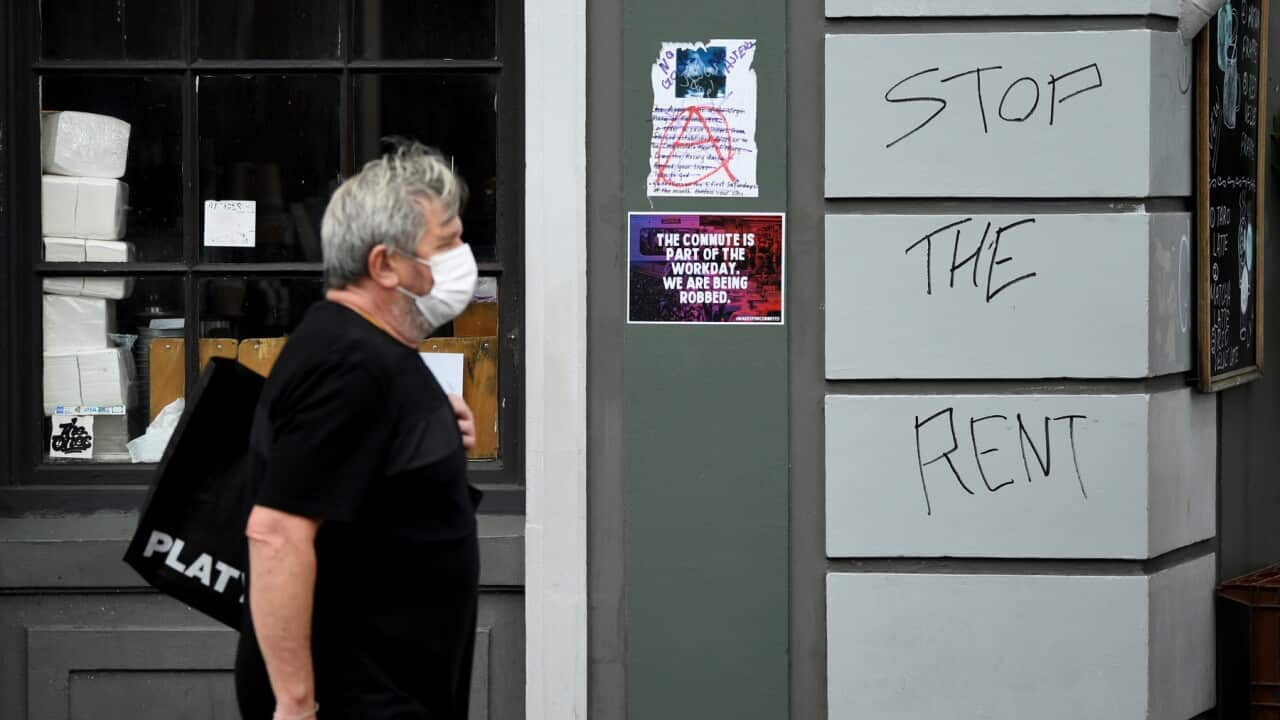When Rachel (not her real name) moved out of home at 19, she didn’t expect her share house to be quite so bad.
Twelve people lived in the house in Sydney’s inner west. It was cramped, dirty and filled with junk.
It originally had only five bedrooms, but four extra bedrooms were later added, including a tiny attic.
“You couldn’t extend your arms fully if you were standing in the room,” Rachel told The Feed.
The basement had been shoddily converted into three extra bedrooms, with thin pieces of wood and shelves from IKEA used for makeshift walls.

Left: Rachel's bedroom walls were hastily put together from thin pieces of wood. Right: a hole in her wall. Source: Supplied
She wasn’t able turn on the overhead lights in her ‘bedroom’, because they were shared with the room across from hers.
“I kind of just lived in the dark because I didn’t have any windows.
“There [were] holes in the wall from where it hadn't been finished building.”

Rachel's bedroom was small and constantly dark because she couldn't use the overhead lights. Source: Supplied
Despite the “not humane” conditions, Rachel ended up staying there for six months.
“It made sense at the time, just because it's so difficult to find places in Sydney…we were all kind of desperate,” she said.

Rachel says the share house residents were recorded with a surveillance camera. Source: Supplied
It's getting harder to find a share house
Share houses are a cost-effective way of renting and are often considered a rite of passage for young people moving out of the family home. They consist of multiple unrelated people living in the same property and sharing facilities.
But it’s more difficult than ever to nab a room.
When Rachel moved to Sydney from Adelaide in mid-2022, she was forced to live in her car and went on a “ruthless” search of different websites before finding her share house.
The Feed has obtained data from two of Australia’s biggest share accommodation websites, Flatmates.com.au and Flatmate Finders, which shows skyrocketing demand for rooms in every capital city.
In Sydney, there are 14 people searching for rooms for every one room available. In Perth, the ratio is even worse at 16:1.

Source: SBS
In January, there were nearly 2,000 people searching for rooms in the Sydney suburb of Surry Hills, while more than 1,300 were eyeing Bondi Beach.

Source: SBS
Share houses are becoming more expensive
With rental vacancy rates hitting record lows – the rate was 0.9 per cent and in Melbourne 0.8 per cent - it’s becoming more expensive to rent in Australia. And share houses are not immune.
The average price of rooms went up in all capital cities between 2019 and 2023, data from Flatmate Finders shows. Sydney topped the list at $325 per room.
If you’re looking for a share house in Perth, you’ll be forking out an extra 33 per cent – with the average room in costing $225.
Meanwhile, Adelaide residents are paying 23 per cent more than they did in 2019, at $208 per room.

Source: SBS
The conditions can be exploitative
Rachel said her experience living in a share house was “uncomfortable” – and she’s not alone.
Zahra Nasreen, a housing researcher at the University of Sydney, found 13 per cent of Sydney’s share houses are overcrowded.
In the worst cases, she’s seen up to 14 people living in two-bedroom units – even resorting to sharing beds.
“They can't function properly, they have to wait for their turns to perform their daily routines, like cooking, showers and sleeping,” Ms Nasreen said.
Ms Nasreen said living in overcrowded share houses can lead to health issues such as disturbed sleep patterns, noise-related complaints and mental health issues.
“These overcrowded units actually can be defined under the conditions of homelessness, either emotionally or physically,” Ms Nasreen said.

A share house room advertised for rent in Sydney, intended for four people. Credit: Reddit/Shoddy_Cauliflower82
How many people live in share houses?
Chris Martin, a researcher at UNSW’s City Futures Research Centre, believes house sharing is making a comeback after COVID-19, when people were more reluctant to enter into a share house situation.
“As interest rates start to contract the economy and more and more people are less secure in their jobs…they start exiting homes of their own, and they start sharing again,” he said.
But Mr Martin believes the true figure could be much higher, due to some share houses being counted as couple households.
Who is looking for a share house?
It’s often assumed only young people live in share accommodation. But Mr Martin said the age demographic of share home inhabitants is changing due to rental pressures.
“We know people are renting longer into their lives, and we suspect people are sharing longer into their lives as well,” Mr Martin said.
In her study, Ms Nasreen came across many older people living in share homes, including single mothers and people in their 50s and 60s.
She found Sydney’s share house residents are mostly international students and other migrants, such as temporary visa holders, refugees and working holidaymakers.
What are your rights if you live in shared housing?
Knowing your rights as a share house resident can be complicated. There’s no single set of rental laws covering share houses in particular.
Your rights and obligations depend on what state you are in and what kind of agreement you have with your rental provider.
Rachel never signed a written agreement with her rental provider. Because of this, she was not considered a tenant in NSW.
“There’s a special rule that says if you occupy a share household, your agreement with the head tenant has to be in writing for you to be under the Residential Tenancies Act,” Mr Martin explained.
This is different to non-shared households, where you are still protected as a tenant even if you never signed a lease.
Rachel would have been considered a lodger in a general boarding house. Lodgers have very limited legal rights.

Rachel's share house was dirty and cluttered with junk. Source: Supplied
Lodgers are entitled to four weeks’ notice before a rent increase.
“The resident must not be evicted without reasonable written notice. As far as what ‘reasonable’ is, it’s not defined – it depends on why the proprietor wants to end it,” Mr Martin said.
Mr Martin said regulators don’t have much insight into the private rental sector.
He is advocating for a Shared Accommodation Act to be created, which would outline a “sensible set of rules for sharing”.
This would create special laws specific to share houses, clarifying practices such as minimum standards of living, splitting bills and disputes between housemates.
“If you're the person who rents the spare room and someone else is calling the shots as to who else moves in, there are risks with that, and that does justify a higher level of regulation.”
Rachel has now moved out of the shared home and is living with her partner.
“My boyfriend was like, ‘Hey, would you want to move in together?' I was like, ‘F-ck yes, get me out of here!’”
Additional reporting by Kenneth Macleod.












